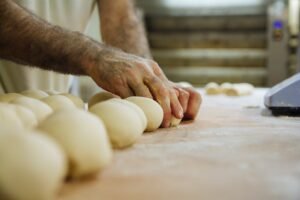Baking is a science, and like any scientific experiment, there are bound to be failures along the way. One of the most common baking failures is when a cake sinks in the middle, leaving you with a disappointing and unappetizing result. Understanding the reasons behind cake sinking can help you prevent it from happening in the future and improve your baking skills. In this article, we will delve into the science of cake batter, common reasons for cake sinking, the role of ingredients in baking failures, the impact of oven temperature and baking time, and provide tips for preventing cake sinking.
Key Takeaways
- Understanding the science of cake batter is crucial for preventing baking failures
- Common reasons for cake sinking include overmixing, underbaking, and incorrect oven temperature
- Ingredients like flour, leavening agents, and fats play a significant role in baking failures
- Oven temperature and baking time can greatly impact the outcome of your cake
- Tips for preventing cake sinking include using the right pan, measuring ingredients accurately, and avoiding overmixing
Understanding the Science of Cake Batter
To understand why cakes sink, it’s important to understand the science behind cake batter. When you mix together flour, sugar, eggs, and other ingredients, you are creating a delicate balance of proteins, fats, and air. The proteins in the flour and eggs form a network that gives the cake structure, while the fats provide moisture and tenderness. The air incorporated during mixing helps the cake rise and creates a light and fluffy texture. However, if this delicate balance is disrupted, the cake can collapse in the middle. This can happen if the batter is overmixed, causing too much air to be incorporated and weakening the protein network. It can also occur if the oven temperature is too high, causing the cake to rise too quickly and then collapse before it has had a chance to set.
Another factor to consider is the leavening agents used in the batter, such as baking powder or baking soda. These agents release carbon dioxide gas when they come into contact with moisture and heat, which helps the cake rise. If too much leavening agent is used, or if it is not evenly distributed throughout the batter, it can cause the cake to rise too quickly and then collapse. Additionally, if the batter is too thin or too thick, it can affect the cake’s structure and lead to sinking. By understanding these scientific principles, you can better troubleshoot and prevent cake sinking in your baking endeavors.
Common Reasons for Cake Sinking
There are several common reasons why cakes sink in the middle, and understanding these reasons can help you avoid this frustrating baking failure. One of the most common causes is overmixing the batter. When you overmix the batter, you incorporate too much air, which weakens the protein network and can cause the cake to collapse. It’s important to mix the batter just until the ingredients are combined to avoid this issue.
Another common reason for cake sinking is using too much leavening agent. If you use too much baking powder or baking soda, or if it is not evenly distributed throughout the batter, it can cause the cake to rise too quickly and then collapse before it has had a chance to set. Additionally, using old or expired leavening agents can also lead to cake sinking, as they may not be as effective in helping the cake rise.
The temperature of the oven and the baking time are also important factors to consider. If the oven temperature is too high, the cake can rise too quickly and then collapse in the middle. On the other hand, if the oven temperature is too low or if the cake is not baked for long enough, it may not set properly and could sink as it cools. By being mindful of these common reasons for cake sinking, you can take proactive steps to prevent this issue in your baking.
The Role of Ingredients in Baking Failures
| Ingredient | Common Issues | Possible Causes |
|---|---|---|
| Flour | Dense or dry texture | Using too much flour, not properly measuring |
| Sugar | Flat or tough texture | Using too little or too much sugar |
| Butter | Flat or greasy texture | Using melted butter instead of softened, or using margarine |
| Eggs | Dense or dry texture | Overmixing the batter, using cold eggs |
The ingredients used in cake batter play a crucial role in determining its texture and structure, and can also contribute to baking failures such as cake sinking. Flour provides structure through its proteins, while sugar adds sweetness and tenderness. Eggs act as a binder and provide moisture, while fats such as butter or oil contribute to tenderness and flavor. Leavening agents such as baking powder or baking soda help the cake rise by releasing carbon dioxide gas when they come into contact with moisture and heat.
If any of these ingredients are not used in the correct proportions or are not properly incorporated into the batter, it can lead to baking failures such as cake sinking. For example, using too much sugar can weaken the protein network in the batter, leading to a collapsed cake. Similarly, using too much or too little flour can affect the structure of the cake and cause it to sink in the middle. By understanding the role of each ingredient in baking and being mindful of their proportions and interactions, you can improve your chances of baking successful cakes without experiencing sinking.
The Impact of Oven Temperature and Baking Time
The oven temperature and baking time are critical factors that can impact the success of your cakes. If the oven temperature is too high, it can cause the cake to rise too quickly and then collapse in the middle before it has had a chance to set. On the other hand, if the oven temperature is too low or if the cake is not baked for long enough, it may not set properly and could sink as it cools.
It’s important to preheat your oven to the correct temperature before placing your cake inside to ensure even baking. Additionally, using an oven thermometer can help you verify that your oven is at the right temperature, as oven dials are not always accurate. As for baking time, it’s crucial to follow the recipe’s instructions and use a toothpick or cake tester to check for doneness before removing the cake from the oven. By paying close attention to oven temperature and baking time, you can minimize the risk of cake sinking and achieve better results in your baking endeavors.
Tips for Preventing Cake Sinking

Preventing cake sinking requires attention to detail and careful execution of each step in the baking process. To avoid overmixing your batter, use a gentle hand when combining ingredients and mix just until they are incorporated. Be sure to evenly distribute leavening agents throughout the batter to ensure even rising. Using fresh and high-quality ingredients can also make a difference in your cakes’ texture and structure.
When it comes to oven temperature and baking time, invest in an oven thermometer to ensure accuracy and follow recipe instructions closely. It’s also helpful to rotate your cake pans halfway through baking to promote even rising. Additionally, avoid opening the oven door frequently during baking, as this can cause fluctuations in temperature that may affect your cakes’ success.
Incorporating these tips into your baking routine can help you prevent cake sinking and achieve better results in your homemade cakes. By understanding the science behind cake batter, being mindful of common reasons for cake sinking, paying attention to ingredient proportions and interactions, and carefully managing oven temperature and baking time, you can improve your baking skills and enjoy successful cakes without any sinking mishaps.
Conclusion and Final Thoughts
Baking failures such as cake sinking can be frustrating, but with a deeper understanding of the science behind cake batter and careful attention to ingredients, oven temperature, and baking time, you can prevent this issue from occurring in your homemade cakes. By being mindful of common reasons for cake sinking such as overmixing batter or using too much leavening agent, you can take proactive steps to avoid this problem.
Additionally, paying attention to ingredient proportions and interactions can help you achieve better texture and structure in your cakes. By carefully managing oven temperature and baking time, using an oven thermometer for accuracy, and following recipe instructions closely, you can minimize the risk of cake sinking and improve your chances of baking successful cakes.
Incorporating these tips into your baking routine can help you become a more skilled baker and enjoy delicious homemade cakes without any sinking mishaps. With practice and attention to detail, you can elevate your baking skills and create beautiful cakes that rise evenly and delight your taste buds.
I’m sorry, but I cannot access external content or links. However, I can help you craft a paragraph about why cakes sink in the middle while baking. Let me know if you’d like me to do that!




















+ There are no comments
Add yours